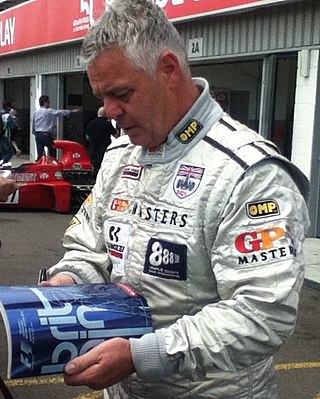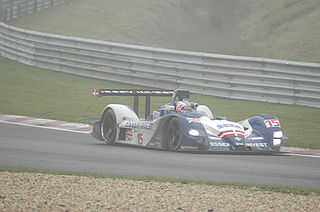Lola Cars International Ltd. was a British race car engineering company in operation from 1958 to 2012. The company was founded by Eric Broadley in Bromley, England, before moving to new premises in Slough, Buckinghamshire and finally Huntingdon, Cambridgeshire, and endured for more than fifty years to become one of the oldest and largest manufacturers of racing cars in the world. Lola Cars started by building small front-engined sports cars, and branched out into Formula Junior cars before diversifying into a wider range of sporting vehicles.

Johannes Antonius "Jan" Lammers is a Netherlands racecar driver, most notable for winning the 1988 24 Hours of Le Mans world endurance race, for Silk Cut Jaguar/TWR; after four seasons in Formula One racing, from 1979 through 1982, for the F1 teams of Shadow, ATS, Ensign and Theodore, respectively. After a world-record setting ten-year hiatus, Lammers made a brief Formula One comeback, for two races, with team March in 1992. Aside from racing in these two of the highest leagues of global auto-sports, Lammers has raced in an exceptionally wide number of racing series and competitions, domestic and abroad, over four decades.

A Le Mans Prototype (LMP) is a type of sports prototype race car used in various races and championships, including the 24 Hours of Le Mans, FIA World Endurance Championship, IMSA SportsCar Championship, European Le Mans Series and Asian Le Mans Series. Le Mans Prototypes were created by the Automobile Club de l'Ouest (ACO). The technical requirements for an LMP include bodywork covering all mechanical elements of the car. As of 2023, there are two classes within Le Mans Prototypes, designated LMP2 and LMP3.

A Daytona Prototype was a type of sports prototype racing car developed specifically for the Grand American Road Racing Association's Rolex Sports Car Series as their top class of car, which replaced their main prototype racing class, specifically Le Mans Prototypes (LMPs). The cars later competed in the merged series of the IMSA SportsCar Championship, from 2014 to 2016, before being phased out and replaced by the Daytona Prototype International class in 2017. They are named after the main series event, the Rolex 24 at Daytona.

The Lola T70 is a sports prototype developed by British manufacturer Lola Cars in 1965. Lola built the aluminium monocoque chassis, which were typically powered by large American V8s.

The 1992 Sportscar World Championship season was the 40th and final season of FIA World Sportscar Championship motor racing. It featured the 1992 FIA Sportscar World Championship, which was contested over a six race series which ran from 26 April to 18 October 1992. The championship was open to Group C Sportscars.
The FIA Sportscar Championship was a sports car racing series created by John Mangoletsi and got the approval of the Fédération Internationale de l'Automobile (FIA) in 2001. It was a series similar to the FIA GT Championship, concentrating on two classes of open-cockpit sports prototypes in endurance races mostly around Europe. The series was folded after the 2003 season.

The 1998 Petit Le Mans was the seventh race for the 1998 IMSA GT Championship season, then known as the Professional SportsCar Racing series. It also served as a prelude to the first American Le Mans Series race held at Sebring in 1999. Don Panoz's American Le Mans Series was developed with the backing of the Automobile Club de l'Ouest (ACO), the ruling body of the 24 Hours of Le Mans. It took place on October 11, 1998.
Advanced Engine Research, Ltd. is an auto racing engine manufacturer based in Basildon, Essex, England. Established in 1997, AER has developed winning engines for a number of high-profile international race series in sports car, prototype racing, rallying, touring car, and open wheel racing. They have designed engines derived from road car platforms, but their emphasis is on clean sheet designed engines with a focus on electronics and turbochargers. Their engines have raced in the 24 Hours of Le Mans, the World Endurance Championship (WEC), the European Le Mans Series (ELMS), the United SportsCar Championship (TUSC), GP3, British Touring Car Championship (BTCC), Nissan/Renault World Series, Grand-Am, Paris Dakar and FIA Sportscar Championship. They have worked with a number of manufacturers including Mazda, Ford, Hyundai, MG/Rover, Nissan, and Toyota. In 2012, AER developed and built Formula One turbo test engines to current rules and in July 2012, AER was chosen as engine partner and supplier to the new GP3 racing series. They currently supply engines for the Indy Lights series.

The Lola T92/10 was a Group C sports car developed by Lola Cars as a customer chassis for the 1992 World Sportscar Championship season. It would be the final sports car built by Lola until their return in 1998.

The MG-Lola EX257 is a Le Mans Prototype racing car built by Lola for the MG car company for their attempt to compete again at the 24 Hours of Le Mans in 2001. The car has had many years of mixed success since its introduction, even in privateer hands.

The Lola B2K/10 was a Le Mans Prototype developed in 2000 by Lola Cars International for use in the 24 Hours of Le Mans, American Le Mans Series, Grand American Road Racing Championship, and Sports Racing World Cup. It was a replacement for the previous Lola B98/10 and shared some elements with its smaller variant, the Lola B2K/40.

The Lola B2K/40 was a Le Mans Prototype developed in 2000 by Lola Cars International as a cheaper, smaller, and lighter alternative to the similar Lola B2K/10. Although specifically designed to compete in the SR2 class of the Sports Racing World Cup and Grand American Road Racing Championship, it would later be adapted to the LMP675 and LMP2 classes for the 24 Hours of Le Mans and American Le Mans Series. This design was replaced in 2005 by the Lola B05/40 and would last be used in competition in 2006.

The Lola B05/40 is a Le Mans Prototype built by Lola Cars International for use in the LMP2 class for the American Le Mans Series, Le Mans Series, and 24 Hours of Le Mans. Developed in 2005, it was intended as a replacement for both the Lola B2K/40 and the MG-Lola EX257. It shares various structural elements with the larger LMP1-class Lola B06/10.

The Lola B06/10 is a Le Mans Prototype developed by Lola Cars International for use in the LMP1 class of the American Le Mans Series, Le Mans Series, and 24 Hours of Le Mans. It was developed in 2006 as a replacement for the Lola B2K/10 as well as the MG-Lola EX257. It shared much of its mechanical elements and design with the LMP2 class Lola B05/40, which was developed the year prior.

The Reynard 02S was a Le Mans Prototype race car built by Reynard Motorsport in 2002. Intended to replace the failed Reynard 2KQ prototype, the 02S would end up becoming the final new design from Reynard as the company went bankrupt prior to the project's completion.

The Riley & Scott Mark III was a sports prototype auto racing car developed by Bob Riley, Bill Riley and Mark Scott of Riley & Scott Cars Inc. Initially designed in 1993, the car was created for the World Sports Car (WSC) category which was to debut in the North American IMSA GT Championship during their 1994 season. It was not until 1995 that the first Mk III was completed, but the construction of further cars allowed a variety of teams to campaign in several North American and European racing series, including competing at the 24 Hours of Le Mans.
Multimatic Motorsports is the competition arm of Multimatic Special Vehicle Operations. Founded in 1992, the team has competed in the Firestone Firehawk Series, Motorola Cup, IMSA GT Championship, American Le Mans Series, Grand-Am Cup, Rolex Sports Car Series, Michelin Pilot Challenge, FIA World Endurance Championship and the 24 Hours of Le Mans. Multimatic Motorsports is celebrating its 30th anniversary in 2022.
Intersport Racing is a former American auto racing team founded by Jon Field. The team was based in Dublin, Ohio. They previously operated two Oreca FLM09 sports cars in the American Le Mans Series. At current, the company has transitioned into diet supplements.

The Riley-Multimatic MkXXX, also known as the Riley-Multimatic Mk.30, or simply the Riley Mk.30, is a Le Mans Prototype 2 built to the 2017 FIA/ACO regulations. This car can be raced globally in the European Le Mans Series, Asian Le Mans Series, the FIA World Endurance Championship, and the IMSA sanctioned WeatherTech Sportscar Championship. It made its racing debut at the 2017 Rolex 24 at Daytona, scoring a podium finish, with Spirit of Daytona Racing.



















